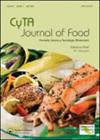The microbial composition and functional roles of different kombucha products in Singapore
IF 1.7
4区 农林科学
引用次数: 0
Abstract
Kombucha is a fermented tea known for its health-enhancing properties owing to the bioactive compounds generated by acetic acid bacteria (AAB) and lactic acid bacteria (LAB). We compared the distribution of AAB and LAB across nine kombucha products in Singapore (Product A to I) using shotgun metagenomics. High prevalence of Komagataeibacter species including Komagataeibacter saccharivorans (82.93% in B), Komagataeibacter xylinus (93.38% in D), and Komagataeibacter rhaeticus (92.20% and 30.62% in G and I) was detected in AAB-dominant kombucha. LAB-dominant kombucha was represented mainly by Bacillus coagulans (~99% in E and F) and Lactobacillus nagelii (~60% in H). Despite differences in bacterial composition, all kombucha harbour pathways involved in the biosynthesis of short-chain fatty acids (SCFAs), amino acids and vitamin B12. Interestingly, “fatty acid and beta-oxidation II (peroxisome)” and “fatty acid and beta-oxidation I” were only present in LAB-dominant kombucha. Further study is required to elucidate the significance of the discrepancies.新加坡不同康普茶产品的微生物组成及功能作用
康普茶是一种发酵茶,因其由乙酸菌(AAB)和乳酸菌(LAB)产生的生物活性化合物而闻名于世,具有增强健康的特性。我们使用霰弹枪宏基因组学比较了新加坡9种康普茶产品(产品A到I)中AAB和LAB的分布。在以aab为主的康普茶中检出高发的komagataebacter saccharivorans (B型82.93%)、komagataebacter xylinus (D型93.38%)和rhaeticus komagataebacter (G型92.20%和I型30.62%)。实验室优势菌主要为凝结芽孢杆菌(~99%)和纳格里乳杆菌(~60%)。尽管菌群组成不同,但康普茶的所有途径都参与短链脂肪酸(SCFAs)、氨基酸和维生素B12的生物合成。有趣的是,“脂肪酸和β -氧化II(过氧化物酶体)”和“脂肪酸和β -氧化I”只存在于实验室优势的康普茶中。需要进一步的研究来阐明这些差异的意义。
本文章由计算机程序翻译,如有差异,请以英文原文为准。
求助全文
约1分钟内获得全文
求助全文
来源期刊

Cyta-Journal of Food
FOOD SCIENCE & TECHNOLOGY-
CiteScore
4.40
自引率
0.00%
发文量
37
期刊介绍:
CyTA – Journal of Food is an Open Access journal that publishes original peer-reviewed research papers dealing with a wide range of subjects which are essential to the food scientist and technologist. Topics include: chemical analysis of food; additives and toxins in food; sensory, nutritional and physiological aspects of food; food microbiology and biotechnology; changes during the processing and storage of foods; effect of the use of agrochemicals in foods; quality control in food; and food engineering and technology.
 求助内容:
求助内容: 应助结果提醒方式:
应助结果提醒方式:


